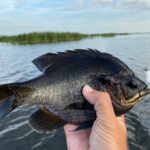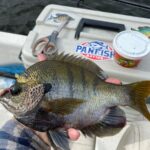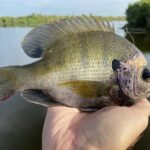Today we’re talking all things minnows!
If you are an avid fisherman, you know that using live bait has many advantages. Using live bait can provide your targeted fish with the movement, smell, taste, and texture of the prey they eat every day.
And one of the most widely used fish for live bait is the minnow…
In this guide, ill answer the question: How long do minnows live, and other frequently asked questions about their lifecycle, reproduction, and more.
Table of Contents
How Long Is a Minnow’s Lifespan?
“True minnows” smaller than three inches generally do not live past the age of two in the wild, and bluntnose minnows have been recorded to live up to five years under perfect conditions. Shiners average three to four years, and common shiners can live up to six years in captivity tanks.
The bluntnose minnow is also referred to as the “common minnow,” as it is the most abundant type of minnow found in freshwater lakes and streams. In the wild, the average lifespan of a bluntnose is between one and two years, and they can live up to five when held in captivity.
The fathead minnow is the most common minnow sold for bait in the US, and most die before reaching the age of two in the wild. An estimated one-fifth of fatheads live to be two years old naturally, and they average a two to three-year lifespan when kept in ideal conditions.
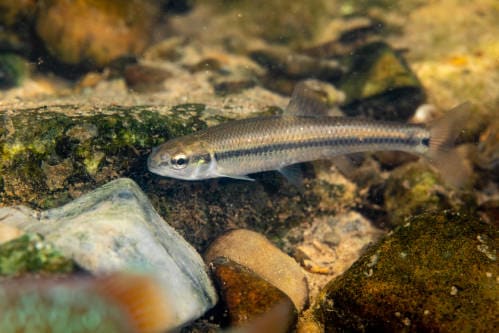
The Mosquitofish also rarely lives past the age of two in the wild, and generally dies before the age of three, even in perfect conditions. Due to the intentional widespread distribution of Mosquitofish throughout the world, their lifespans can vary greatly depending on their location.
Due to the short overall lifespan of these “true minnows,” they should not be tank-kept longer than needed when intended to use for bait. While it is possible for them to survive multiple years, they should be used as soon as possible to avoid wasting baitfish.
The common shiner has the longest lifespan of the six most common minnows found in North America, with an average lifespan of four to six years. In the wild, this number is usually closer to four, while common shiners that survive six years are generally tank-held.
See Also: Minnows vs Shiners: Understanding The Difference
While the emerald and golden shiners are similar to the common shiner in just about every other way, their lifespans are a bit shorter on average. Emerald shiners, in the wild, have an average lifespan of three years, while they can live up to five in captivity.
Shiners can easily be tank-held for over a year, even when being used as baitfish. Shiners are a bit more resilient than “true minnows,” and are also a bit more durable than baitfish due to their larger size. All baitfish should be used in a timely manner, however, to avoid accidental death.
How Long Does It Take Minnows To Reproduce?
Smaller minnows are able to reproduce very quickly and lay eggs multiple times per week. Shiners have a slower reproduction rate, averaging around three to four weeks between spawning. Mosquitofish have live births and are able to reproduce every four to six weeks.
Once sexual maturity is reached, bluntnose minnows can spawn every four to five days, and larger females are able to lay over 600 eggs at one time! Once fertilized by the male, the eggs will hatch after four to eight days.
Fathead minnows lay significantly fewer eggs at a time than bluntnose, averaging between 100 and 400 at a time. They are able to reproduce a bit more quickly, however, with an average of three to five days between spawning. They also hatch faster, after only four to five days.
Mosquitofish are one of the only common minnows to have live births, as opposed to laying eggs. They spawn in the summer months and are able to give birth every four to six weeks.
Common, emerald, and golden shiners all generally spawn between four to five times every summer, giving them an average spawn turnaround of three to four weeks. They lay thousands of eggs at a time, and the average hatch time is between four and seven days.
How Long Are Minnows Pregnant?
Bluntnose and fathead minnows do not become pregnant, and neither do common, emerald, or golden shiners. Mosquitofish are the only common minnow that has live births, and they are usually pregnant between two and four weeks.
All other types of minnows are fertilized externally by the male, after the female releases the eggs. minnows usually spawn under structure, as their eggs are buoyant, and they prefer when the eggs are contained by the structure above. Females can lay hundreds to thousands of eggs.
How Long Does It Take for Minnows To Mature?
Bluntnose and fathead minnows generally reach sexual maturity between three and six months, but environmental factors can play a huge role in this timeline. Warmer waters tend to see “true minnows” mature more quickly, as spawning is usually done in the summer months.
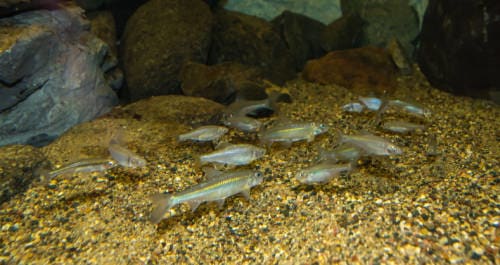
Mosquitofish have a vastly different timeline than other small minnows, with females reaching sexual maturity as quickly as three to four weeks. Males take significantly longer to mature, averaging between six and nine weeks. These timelines are also expedited in warmer waters.
Shiners take the longest to mature of any common minnow, as they require significantly more growth to reach full size compared to smaller baitfish. The soonest shiners have been known to spawn is at around eight months, while most reach maturity between one and two years old.
Difference Between Minnows in the Wild vs Captivity
Minnows generally live significantly longer when held in captivity compared to in the wild. There are a wide variety of factors that lead to this longer lifespan, but predominately, it is due to the lack of predators looking to feed on them. Water temperature and pH can also be adjusted to ideal conditions for captive fish.
Along with having water conditions monitored and maintained at optimal conditions, captive minnows are fed a steady diet of nutrient-dense feed that is designed to deliver them all needed vitamins and minerals.
Fish are also usually paired with cohabitants that help tank conditions by cleaning the bottoms and sides.
While being held in captivity usually leads to a longer lifespan for minnows, there is an element of user error that can shorten these life expectations, especially for new fish owners who are initially setting up their systems.
Many fish can be lost due to unforeseen issues and nuances of a new fish tank.
You May Also Like: How Many Minnows are in a Pound/Gallon/Scoop?
If you haven’t guessed yet, I love fishing and everything about it!
To learn more about why I started Panfish Nation, visit the About page and follow along on Social Media:


Download a copy of my FREE Lure Color Selection Chart & Knot Guide!
Stay up to date with fishing reports, tackle reviews, industry news, and much more! We respect your privacy, unsubscribe at any time.
Related Posts
- Crazy Facts About the World Record Crappie
- What Size Hooks for Smallmouth Bass? Quick Guide
- Large and in Charge-Mouth: 10 of the Best Bass Lures of All Time (And Where to Buy Them)
- Emperor of the Sun(fish): What You Need to Know About the World Record Bluegill
- Coppernose Bluegills: How They’re Different from Common Bluegill
- Bluegill vs Brim: Differences & Terminology, Explained!




